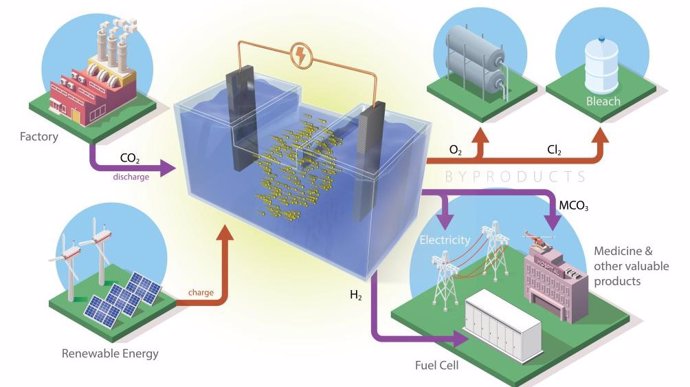The Battery Developed at ORNL, Consisting of Two Electrodes in a Salt Water Solution, Draws Atmospheric Carbon Dioxide into Its Electrochemical Reaction and Releases Only Valuable Byproducts. – ANDY SPROLES/ORNL, US DEPT. OF ENERGY
May 17. () –
The US Oak Ridge laboratory is developing batteries for combat climate change in two ways: expanding the use of renewable energy and capturing carbon dioxide in the air.
This type of battery stores renewable energy generated by solar panels or wind turbines. Using this energy when wind and sunlight are not available requires an electrochemical reaction that, in the new battery formulation, captures carbon dioxide from industrial emissions. and converts it into value-added products.
Oak Ridge researchers recently created and tested two different battery formulations that convert carbon dioxide gas, or CO2, into a solid form that has the potential to be used in other products, the institution reports. it’s a statement.
One of these new types of batteries maintained its capacity for 600 hours of use and could store up to 10 hours of electricity. The researchers also identified, studied and overcame the main challenge, a deactivation caused by the accumulation of chemicals, which had been an obstacle for the other battery formulation.
Batteries work by electrochemical reactions that move ions between two electrodes through an electrolyte. Unlike mobile phone or car batteries, those designed for grid energy storage They do not have to operate as a closed and portable system. This allowed ORNL researchers to create and test two types of batteries that could convert CO2 from stationary industrial sources.
For example, CO2 generated by a power plant could be pumped through a tube into liquid electrolyte, creating bubbles similar to those in a carbonated soft drink. During battery operation, The gas bubbles turn into a solid powder.
Each component of a battery can be made up of different elements or compounds. These options determine the operational life of the battery, how much energy it can store, how large or heavy it is, and how quickly it charges or draws power. Of Oak Ridge’s new battery formulations, one combines CO2 with saltwater sodium using an inexpensive iron-nickel catalyst. The second combines gas with aluminum.
Each method uses abundant materials and a liquid electrolyte in the form of salt water, sometimes mixed with other chemicals. The batteries are safer than existing technology because their electrodes are stable in water, said lead researcher Ruhul Amin.
















Add Comment